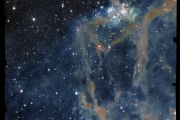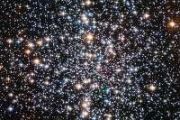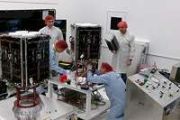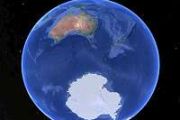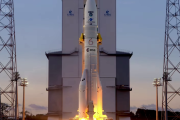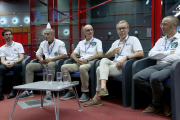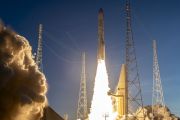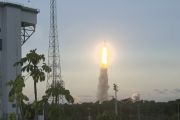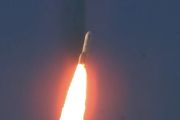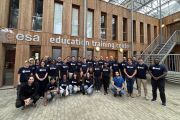
Copernical Team
Empowering Artemis with communications and navigation interoperability
 With Artemis, NASA will establish a long-term presence at the Moon, opening more of the lunar surface to exploration than ever before. This growth of lunar activity will require new, more robust communications, navigation, and networking capabilities. NASA's Space Communications and Navigation (SCaN) program has developed the LunaNet architecture to meet these needs.
LunaNet will leverage
With Artemis, NASA will establish a long-term presence at the Moon, opening more of the lunar surface to exploration than ever before. This growth of lunar activity will require new, more robust communications, navigation, and networking capabilities. NASA's Space Communications and Navigation (SCaN) program has developed the LunaNet architecture to meet these needs.
LunaNet will leverage Highly porous rocks responsible for Bennu's surprisingly craggy surface
 Scientists thought asteroid Bennu's surface would be like a sandy beach, abundant in fine sand and pebbles, which would have been perfect for collecting samples. Past telescope observations from Earth's orbit had suggested the presence of ??large swaths of fine-grain material called fine regolith that's smaller than a few centimeters.
But when the spacecraft of NASA's University of Arizona
Scientists thought asteroid Bennu's surface would be like a sandy beach, abundant in fine sand and pebbles, which would have been perfect for collecting samples. Past telescope observations from Earth's orbit had suggested the presence of ??large swaths of fine-grain material called fine regolith that's smaller than a few centimeters.
But when the spacecraft of NASA's University of Arizona Lasers to probe origin of life on a Moon
 On Saturn's giant moon Titan, liquid methane and other hydrocarbons rain down, carving rivers, lakes and seas in a landscape of frozen water. The complex chemistry on this icy world could be analogous to the period when life first emerged on Earth, or it might yield an entirely new type of life. And even farther - light-years away in deep space, a black hole shreds the ultra-dense core of a dead
On Saturn's giant moon Titan, liquid methane and other hydrocarbons rain down, carving rivers, lakes and seas in a landscape of frozen water. The complex chemistry on this icy world could be analogous to the period when life first emerged on Earth, or it might yield an entirely new type of life. And even farther - light-years away in deep space, a black hole shreds the ultra-dense core of a dead NASA's SLS passes key review for Artemis I ,ission
 NASA has completed the design certification review (DCR) for the Space Launch System Program (SLS) rocket ahead of the Artemis I mission to send the Orion spacecraft to the Moon. The review examined all the SLS systems, all test data, inspection reports, and analyses that support verification, to ensure every aspect of the rocket is technically mature and meets the requirements for SLS's first f
NASA has completed the design certification review (DCR) for the Space Launch System Program (SLS) rocket ahead of the Artemis I mission to send the Orion spacecraft to the Moon. The review examined all the SLS systems, all test data, inspection reports, and analyses that support verification, to ensure every aspect of the rocket is technically mature and meets the requirements for SLS's first f NASA Announces 60 Teams for 2022 Student Launch Competition
 NASA has announced the 60 teams from 22 states and Puerto Rico selected to compete in the 2022 Student Launch - one of seven Artemis Student Challenges. The nine-month challenge, managed by NASA's Southeast Regional Office of STEM Engagement and held at Marshall Space Flight Center in Huntsville, Alabama, provides a realistic experience for middle school, high school, and college students to fol
NASA has announced the 60 teams from 22 states and Puerto Rico selected to compete in the 2022 Student Launch - one of seven Artemis Student Challenges. The nine-month challenge, managed by NASA's Southeast Regional Office of STEM Engagement and held at Marshall Space Flight Center in Huntsville, Alabama, provides a realistic experience for middle school, high school, and college students to fol NASA announces astronaut changes for upcoming Commercial Crew Missions
 NASA has reassigned astronauts Nicole Mann and Josh Cassada to the agency's SpaceX Crew-5 mission to the International Space Station as part of the Commercial Crew Program. Mann and Cassada will serve as spacecraft commander and pilot, respectively, for the Crew-5 mission. Additional crew members will be announced later.
Crew-5 is expected to launch no earlier than fall 2022 on a Falcon 9
NASA has reassigned astronauts Nicole Mann and Josh Cassada to the agency's SpaceX Crew-5 mission to the International Space Station as part of the Commercial Crew Program. Mann and Cassada will serve as spacecraft commander and pilot, respectively, for the Crew-5 mission. Additional crew members will be announced later.
Crew-5 is expected to launch no earlier than fall 2022 on a Falcon 9 Can we ever be safe in space
 Science fiction, which is perhaps more popular than it has ever been, would lead us to believe that space colonization is just a matter of time. The reality, however, is not as promising. The environment that awaits us outside of Earth's atmosphere, even when subjected to our most advanced technology, is brutal and forbidding.
There is a long list of dangers associated with space that are
Science fiction, which is perhaps more popular than it has ever been, would lead us to believe that space colonization is just a matter of time. The reality, however, is not as promising. The environment that awaits us outside of Earth's atmosphere, even when subjected to our most advanced technology, is brutal and forbidding.
There is a long list of dangers associated with space that are Highly porous rocks are responsible for asteroid Bennu's surprisingly craggy surface
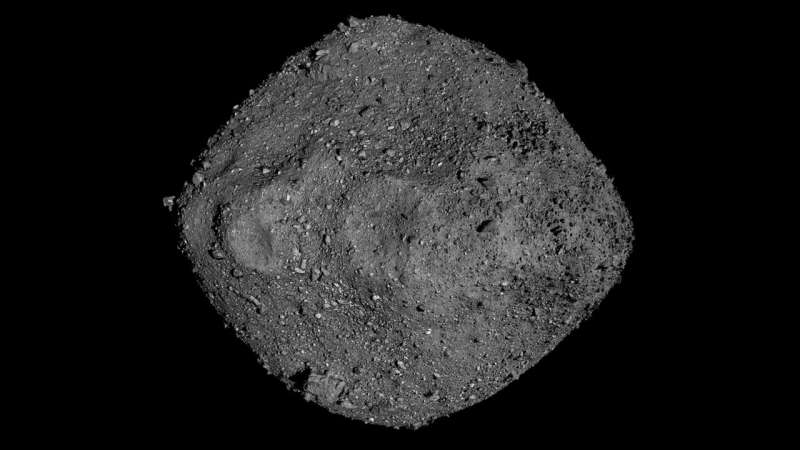
Scientists thought asteroid Bennu's surface would be like a sandy beach, abundant in fine sand and pebbles, which would have been perfect for collecting samples. Past telescope observations from Earth's orbit had suggested the presence of large swaths of fine-grain material called fine regolith that's smaller than a few centimeters.
But when the spacecraft of NASA's University of Arizona-led OSIRIS-REx asteroid sample return mission arrived at Bennu in late 2018, the mission team saw a surface covered in boulders.
Where Earth's water comes from, preparing for DART impact and other lessons from space
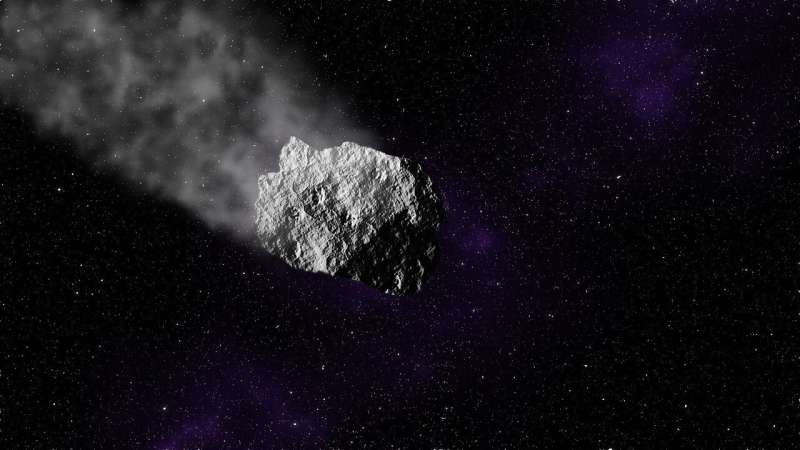
Two NAU astronomers presented groundbreaking research at the annual meeting of the Division for Planetary Sciences, a branch of the American Academy of Sciences.
Where does Earth's water come from?
A Northern Arizona University researcher who studies active asteroids, which are rare asteroids with comet-like tails, presented groundbreaking research today at the annual meeting of the Division for Planetary Sciences, a branch of the American Academy of Sciences.
Colin Chandler, a doctoral student in the Department of Astronomy and Planetary Science at Northern Arizona University and recipient of the NSF Graduate Research Fellowship, presented "Recurrent activity from a Main Belt Comet."
Active asteroids hold clues about the origins of water on Earth and where water can be found today in the solar system. Fewer than 30 of these objects have been discovered since 1949. Most recently, asteroid (248370), also known as 2005 QN173, was found to be active on July 7. Chandler began digging into historical astronomical data to learn more about the object's past, and he and co-authors Chad Trujillo of NAU and Henry Hsieh of the Planetary Science Institute discovered an image from July 2016 that showed the object with a long, thin tail.
NASA Sets Coverage, Invites Public to Virtually Join Lucy Launch
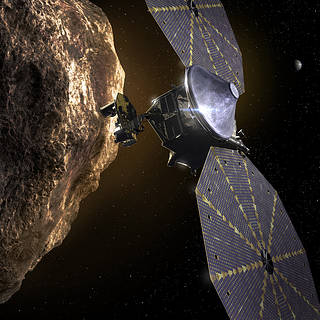 NASA will provide coverage of upcoming prelaunch and launch activities for Lucy, the agency’s first mission to explore the Jupiter Trojan asteroids.
NASA will provide coverage of upcoming prelaunch and launch activities for Lucy, the agency’s first mission to explore the Jupiter Trojan asteroids. 








